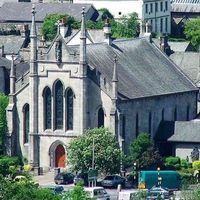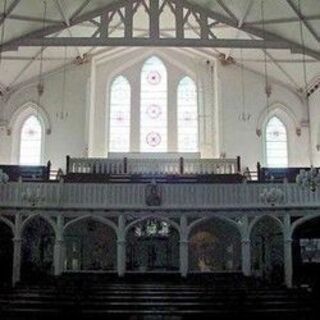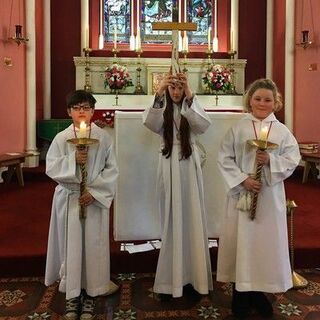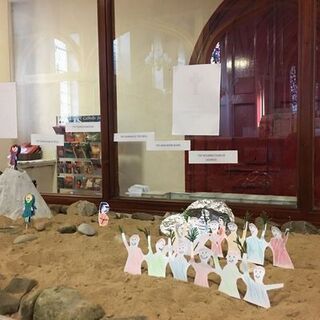- Catholic Churches in Kendal, Cumbria
- Catholic Churches in Cumbria
- Catholic Churches in United Kingdom
- Catholic Churches near me
- All churches in Kendal, Cumbria
Who we are
A Warm Welcome to the Catholic Church in Kendal
We would be delighted if you came to join us in person.
Don’t forget the Thursday Club – it’s a great social occasion, very relaxed, fantastic cakes, very good company with lots of chat and entertainment. If you would like to volunteer – if only once every month or six weeks – please get in touch with Fr Hugh. If you know somebody who is housebound and would like to come, let us know. We provide a wheelchair taxi service. It takes please in the parish centre which is WARM!
We would be delighted if you came to join us in person.
Don’t forget the Thursday Club – it’s a great social occasion, very relaxed, fantastic cakes, very good company with lots of chat and entertainment. If you would like to volunteer – if only once every month or six weeks – please get in touch with Fr Hugh. If you know somebody who is housebound and would like to come, let us know. We provide a wheelchair taxi service. It takes please in the parish centre which is WARM!
Street Address

33 Blackhall Road
Kendal,
Cumbria
LA9 4BW
United Kingdom
Phone: (01539) 720063
Fax: (01539) 723446
Download Holy Trinity and St George vCard with Mass Times
Click here to contact the church
Church Pastor

Rev Hugh Pollock
Parish Priest
33 Blackhall Road
Kendal,
Cumbria
LA9 4BW
United Kingdom
Phone: (01539) 720063
Fax: (01539) 723446
Download Parish Priest Rev Hugh Pollock vCard
Click here to contact Rev Hugh Pollock
Denomination
Catholic Church
Affiliations
Church Website
Holy Trinity and St George on Social Media
Leadership
Leader Name:
Rev Hugh Pollock
Leader Position:
Parish Priest
Formal Title:
Leader Address:
Phone:
Fax:
(01539) 723446
Leader Email:
Click here to contact Rev Hugh Pollock
Leader Bio:
Rev Hugh Pollock on Social Media:
Other Church Leaders:
Leadership Photos
Add a Photo
Administration
Admin Name:
Admin Position:
Admin Address:
Phone:
Fax:
Admin Email:
Mailing Address
Driving Directions
Travel/Direction Tips
Know how to get there? Share the knowledge with others!
Parking
Please share parking information and/or parking experience!
Holy Trinity and St George Mass Times
Sunday Mass Times
Vigil Mass – Saturday @ 6:00 PM, Sunday Masses – 10:00 AM & 6:00 PM,
Sunday Mass in Sedbergh @ 12:00 Noon.
Confessions are every Saturday from 5:10 PM to 5:40 PM
Weekday Mass Times
Mondays @ 9.15am, Tuesdays @ 12.15pm, Wednesdays @ 7pm and Thursdays and Fridays @ 12.15pm
It's been more than 6 years since the last mass times update. Please make sure to contact the church to confirm mass times.
Please contact the church to confirm Mass Times or SUBSCRIBE to updates below
Vigil Mass – Saturday @ 6:00 PM, Sunday Masses – 10:00 AM & 6:00 PM,
Sunday Mass in Sedbergh @ 12:00 Noon.
Confessions are every Saturday from 5:10 PM to 5:40 PM
Weekday Mass Times
Mondays @ 9.15am, Tuesdays @ 12.15pm, Wednesdays @ 7pm and Thursdays and Fridays @ 12.15pm
It's been more than 6 years since the last mass times update. Please make sure to contact the church to confirm mass times.
Please contact the church to confirm Mass Times or SUBSCRIBE to updates below
Worship Languages
Dress Code
Sunday School / Children and Youth Activities
Under 12s:
Under 18s:
Local outreach & community activities
Other activities & ministries
Special Needs/Accessibility
Prayers and Hymns
Main Bible:
Hymns and Songs:
Other information
Average Adult Congregation:
Average Youth Congregation:
Additional Info:
Holy Trinity and St George Church Kendal Photos
Holy Trinity and St George History
History of Holy Trinity & St. George, Kendal
Consecrated 1837
The present church of the Holy Trinity and St. George described here replaced an earlier chapel in 27 Stramongate. A house in Stramongate had been acquired from the Braithwaite family some time after 1762. Robert Stephenson of Dodding Green bought this house in which was a chapel in disguise. Later, these premises were to become a new chapel in 1793. The present church and the 1793 chapel were the work of Rev. Thomas Wilkinson, priest of this parish for a remarkable sixty years. Today’s church was built at a cost of £4000 and the foundation stone was laid in October 1835. It was opened on the 15th September 1837 and met the needs of a rising Catholic population.
The building was designed by the renowned local architect George Webster who was responsible for other fine buildings in Kendal. The neo-Gothic style of architecture was fashionable in the 1830’s and this church is a good example of it. From the outside, before you enter the vestibule, glance up at the statue of St. George in the act of slaying a dragon. This fine piece of sculpture is the work of Thomas Duckett, a trained wood carver and employee of Francis and George Webster, the architects. Two more examples of Duckett’s work may be seen inside the church. These are statues, Ecce Homo on the left and St. George on the right. Two other sculptures of the Virgin Mary and St. Mary Magdalene have disappeared. The ceiling pendants and panelling are also Duckett’s work. The floor of the church was raised in 1908 after the devastating floods which resulted in damage to the fabric and furniture. Electricity replaced gas in 1927.
Inevitably over a span of 165 years this building has undergone many changes. Some of them have been circumstantial, e.g. the raising of the level of the floor in 1908 to cope with the constant flooding by the overflowing River Kent. Some changes have reflected the various liturgical renewals of the past two centuries, particularly those of the Second Vatican Council. In recent years the parish has sought to stabilize the church fabric and make it more watertight, and latterly to enhance the interior of the church for use by the parishioners in worshipping God. Until recently the entrance to the church on New Road was rather dark and drear.
In 2002 a new vestibule and narthex were created using the existing ‘gathering space.’ This has imaginatively opened up the entrance and given an immediate view of the beautiful stained glass window behind the altar. In this phase of works a piety stall has been installed. Once through the glass screen door into the church you are greeted with the stained glass windows in the church which are of fine quality and enhance the church interior by their richness of colour.
Behind the altar is a three light window. In the central light is shown the founder of the church, Rev. Thomas Wilkinson, the long serving pastor and priest in Kendal. He is shown kneeling, offering the church he built to Christ. In the left light, St. Cuthbert, patron of the diocese, looks on. In the right hand light is St. George. These windows are the work of John Hardman of Birmingham. The two chancel windows depict, right, St. Joseph and, left, St. Anne, mother of the Virgin Mary. Both were made by H. Barnett of Newcastle upon Tyne.
On the south wall is a window dedicated to Rev. James Gibson who followed Fr. Wilkinson, serving 47 years. It is a fine piece of design and shows The Good Shepherd and St. Peter. A second window depicts St. John, holding in his hand a quill pen, and below, St. Simon’s crucifixion and the execution of St. Dorothea. Both windows are by Hardman. The middle window on the south wall is by Meyer of Munich. It is undated but is a very good example of late 19th century glass. On the north wall a beautiful window shows the Madonna Child with St. George and St. Catherine. The artist is unknown. In 2002 the windows were fitted with uplights. In the vestibule are four small glass panels which are very old and earlier than the church. They are of continental origin. It is tempting to suggest that Fr. Wilkinson brought these with him from Douai when the college there was closed.
Furniture
The present organ, situated close to the chancel, is a new addition installed in April 2000. It is an electronic organ which uses computer technology. It has ‘chips’ which have digitally sampled English cathedral organs, the sound of which is faithfully reproduced on the new instrument. This organ superseded the previous one which was situated in the gallery at the rear of the church and was brought here from Whitbarrow Lodge in 1935. That organ was an adapted Aeolian Organ which has been transferred to the Musical Museum in Brentford. It replaced an earlier small pedal harmonium which, in its turn, replaced the original 1837 organ by Davis of Liverpool.
One of the two wooden side altars, that dedicated to the Sacred Heart, was constructed and carved by W. W. Cornthwaite, who was organist at this church for 40 years through to 1925. The other altar on the opposite wall bears a statue of the Virgin Mary and Child. This altar was at one time used as the altar of repose. It was used temporarily in 1908, for the celebration of Mass when the floor was raised. Mass was said in St. George’s Hall. Both these side altars were originally to be seen beneath the chancel windows.
In the 1980s certain works were undertaken on the sanctuary to bring it into line with the liturgical reforms of the Second Vatican Council. These works were completed in 2002 when the original altar was taken back to its place under the tabernacle and a new marble altar, with matching ambo and presidential chair, installed. This has meant a slight re-modelling of the sanctuary which is now bound by the chancel arch. Two items retained from a previous re-ordering come from the pulpit used in the 1973 chapel. They are the small carving of a lamb, now to be seen on the church side wall of the piety stall and a panel depicting the descent of the Holy Spirit which is now on the wall by the font. Both are of great beauty and extremely high quality. Also on the wall by the font hangs a panel taken from the baptistery which was housed where the confessional now is. In 2000 the baptismal font was moved onto the sanctuary to allow a space to be created at the front of church for the use of those in wheelchairs.
The nearby panel depicts the Resurrection. It is not of such good quality as that of the Holy Spirit, but nevertheless was carved by someone with a love of their faith. It is of great age and probably pre-dates the 1793 chapel. It may well be a panel which formed part of a secret chapel of the penal times and is the most valuable object in the church. The crucifix was purchased by Fr. Gracey soon after he arrived in 1932. It hung on the wall below the chancel window of St. Joseph and the child Jesus. It has now returned to a position envisaged by Fr. Gracey, suspended above the altar of sacrifice, but in such a position as not to obscure the windows.
The two Holy Water stoups at the entrance to the church are the work of Sylvester Mooney and bear the date 1837, the year the church was built. The Holy Water stoups are of Kendal marble, that is, flawless polished limestone. The church today presents a different appearance to that of 1836. Perhaps the raising of the floor gives a feeling of greater width. The roof timbers then were dark in colour and there were two heavy dark oak doors beneath the chancel windows. The altar rails, dark with gilded ornamentations, curved round to the chancel wall allowing access to the two doors and connection passage which ran round the rear of the apse leading on to the sacristy. There was an ornate reredos covering the entire wall behind the altar. The three bays of the original altar where richly carved and gilded. The original pews were gated and attracted a quarterly rent.
A metal tie bar can be seen spanning the sanctuary arch. This was placed in position as recently as October 1998. It was speedily followed by a second tie bar which spans the gallery and also acts as a guard rail. These were needed to remedy structural defects and cost in excess of £10,000. In 2001 the former organ gallery was upgraded and now provides extra seating capacity.
The upgrading of the lighting system in the body of the church took place in 1999. This provided ten chandelier light fittings which enhanced the ambience of the church.
In the Jubilee year 2000 the parish decided to mark this celebration of the incarnation of Christ by installing an electronic bell system. This was principally to sound the ‘Angelus’, that prayer which recounts the incarnation of Christ. It also had the added advantage of giving the church other bell peals to use.
List of Parish Priests at Kendal since 1803: 1803-1853 Rev. Thomas Wilkinson 1853-1895 Rev. James Gibson 1895-1927 Rev. William Stevenson 1927-1932 Rev. Henry Gillett 1932-1953 Rev. A. L. Gracey 1953-1956 Rev. J. C. Cromblehome 1956-1960 Rev. Thomas Candlish 1961-1966 Rev. John J. Moxham 1966-1978 Rev. William McBride 1978-1983 Rev. Michael Taylor 1983-1996 Rev. Alfred Parker 1996-2008 Rev. Christopher Loughran 2008-2012 Rev. Paul Embery 2012- date Rev. Hugh Pollock
Consecrated 1837
The present church of the Holy Trinity and St. George described here replaced an earlier chapel in 27 Stramongate. A house in Stramongate had been acquired from the Braithwaite family some time after 1762. Robert Stephenson of Dodding Green bought this house in which was a chapel in disguise. Later, these premises were to become a new chapel in 1793. The present church and the 1793 chapel were the work of Rev. Thomas Wilkinson, priest of this parish for a remarkable sixty years. Today’s church was built at a cost of £4000 and the foundation stone was laid in October 1835. It was opened on the 15th September 1837 and met the needs of a rising Catholic population.
The building was designed by the renowned local architect George Webster who was responsible for other fine buildings in Kendal. The neo-Gothic style of architecture was fashionable in the 1830’s and this church is a good example of it. From the outside, before you enter the vestibule, glance up at the statue of St. George in the act of slaying a dragon. This fine piece of sculpture is the work of Thomas Duckett, a trained wood carver and employee of Francis and George Webster, the architects. Two more examples of Duckett’s work may be seen inside the church. These are statues, Ecce Homo on the left and St. George on the right. Two other sculptures of the Virgin Mary and St. Mary Magdalene have disappeared. The ceiling pendants and panelling are also Duckett’s work. The floor of the church was raised in 1908 after the devastating floods which resulted in damage to the fabric and furniture. Electricity replaced gas in 1927.
In 2002 a new vestibule and narthex were created using the existing ‘gathering space.’ This has imaginatively opened up the entrance and given an immediate view of the beautiful stained glass window behind the altar. In this phase of works a piety stall has been installed. Once through the glass screen door into the church you are greeted with the stained glass windows in the church which are of fine quality and enhance the church interior by their richness of colour.
On the south wall is a window dedicated to Rev. James Gibson who followed Fr. Wilkinson, serving 47 years. It is a fine piece of design and shows The Good Shepherd and St. Peter. A second window depicts St. John, holding in his hand a quill pen, and below, St. Simon’s crucifixion and the execution of St. Dorothea. Both windows are by Hardman. The middle window on the south wall is by Meyer of Munich. It is undated but is a very good example of late 19th century glass. On the north wall a beautiful window shows the Madonna Child with St. George and St. Catherine. The artist is unknown. In 2002 the windows were fitted with uplights. In the vestibule are four small glass panels which are very old and earlier than the church. They are of continental origin. It is tempting to suggest that Fr. Wilkinson brought these with him from Douai when the college there was closed.
One of the two wooden side altars, that dedicated to the Sacred Heart, was constructed and carved by W. W. Cornthwaite, who was organist at this church for 40 years through to 1925. The other altar on the opposite wall bears a statue of the Virgin Mary and Child. This altar was at one time used as the altar of repose. It was used temporarily in 1908, for the celebration of Mass when the floor was raised. Mass was said in St. George’s Hall. Both these side altars were originally to be seen beneath the chancel windows.
The two Holy Water stoups at the entrance to the church are the work of Sylvester Mooney and bear the date 1837, the year the church was built. The Holy Water stoups are of Kendal marble, that is, flawless polished limestone. The church today presents a different appearance to that of 1836. Perhaps the raising of the floor gives a feeling of greater width. The roof timbers then were dark in colour and there were two heavy dark oak doors beneath the chancel windows. The altar rails, dark with gilded ornamentations, curved round to the chancel wall allowing access to the two doors and connection passage which ran round the rear of the apse leading on to the sacristy. There was an ornate reredos covering the entire wall behind the altar. The three bays of the original altar where richly carved and gilded. The original pews were gated and attracted a quarterly rent.
In the Jubilee year 2000 the parish decided to mark this celebration of the incarnation of Christ by installing an electronic bell system. This was principally to sound the ‘Angelus’, that prayer which recounts the incarnation of Christ. It also had the added advantage of giving the church other bell peals to use.
List of Parish Priests at Kendal since 1803: 1803-1853 Rev. Thomas Wilkinson 1853-1895 Rev. James Gibson 1895-1927 Rev. William Stevenson 1927-1932 Rev. Henry Gillett 1932-1953 Rev. A. L. Gracey 1953-1956 Rev. J. C. Cromblehome 1956-1960 Rev. Thomas Candlish 1961-1966 Rev. John J. Moxham 1966-1978 Rev. William McBride 1978-1983 Rev. Michael Taylor 1983-1996 Rev. Alfred Parker 1996-2008 Rev. Christopher Loughran 2008-2012 Rev. Paul Embery 2012- date Rev. Hugh Pollock
Holy Trinity and St George Historical Photos
Add a historical photo
 Give us vision
Give us vision
Give to us clear vision that we may know where to stand and what to stand for -- because unless we stand for something, we shall fall for anything.
Holy Trinity and St George listing was last updated on the 7th of March, 2018











